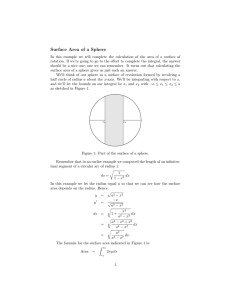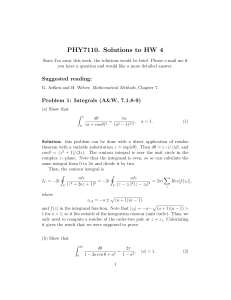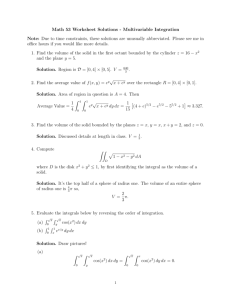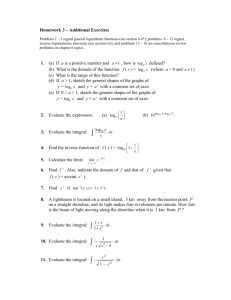Solid State Physics Homework Set 5 Solutions
advertisement
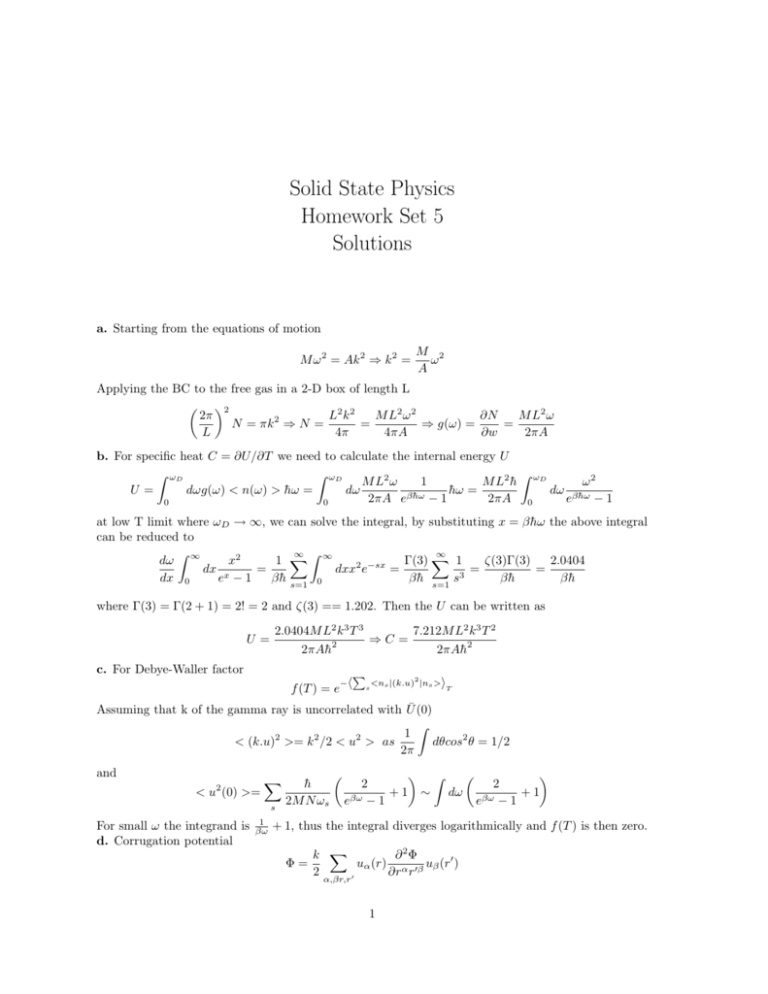
Solid State Physics Homework Set 5 Solutions a. Starting from the equations of motion M ω 2 = Ak 2 ⇒ k 2 = M 2 ω A Applying the BC to the free gas in a 2-D box of length L µ ¶2 2π L2 k 2 M L2 ω 2 ∂N M L2 ω N = πk 2 ⇒ N = = ⇒ g(ω) = = L 4π 4πA ∂w 2πA b. For specific heat C = ∂U/∂T we need to calculate the internal energy U Z ωD Z ωD Z M L2 ω ω2 1 M L2 h̄ ωD dω dωg(ω) < n(ω) > h̄ω = dω h̄ω = U= 2πA eβh̄ω − 1 2πA 0 eβh̄ω − 1 0 0 at low T limit where ωD → ∞, we can solve the integral, by substituting x = βh̄ω the above integral can be reduced to Z ∞ Z ∞ Γ(3) X 1 x2 dω ∞ 1 X ∞ ζ(3)Γ(3) 2.0404 dxx2 e−sx = dx x = = = dx 0 e −1 βh̄ s=1 0 βh̄ s=1 s3 βh̄ βh̄ where Γ(3) = Γ(2 + 1) = 2! = 2 and ζ(3) == 1.202. Then the U can be written as U= 2.0404M L2 k 3 T 3 7.212M L2 k 3 T 2 ⇒ C = 2πAh̄2 2πAh̄2 c. For Debye-Waller factor − f (T ) = e h P s <ns |(k.u)2 |ns >i T Assuming that k of the gamma ray is uncorrelated with Ū (0) Z 1 < (k.u)2 >= k 2 /2 < u2 > as dθcos2 θ = 1/2 2π and < u2 (0) >= X s For small ω the integrand is d. Corrugation potential 1 βω h̄ 2M N ωs µ 2 +1 βω e −1 ¶ ∼ Z dω µ 2 +1 βω e −1 ¶ + 1, thus the integral diverges logarithmically and f (T ) is then zero. Φ= k X ∂2Φ uα (r) α 0β uβ (r0 ) 2 ∂r r 0 α,βr,r 1 where ∂2Φ = δαβ δrr0 k ∂rα r0β thus Dαβ (r − r 0 ) is modified as Dαβ (r) = δr,0 δαβ 2c − crα rβ /d2 + δαβ δr,0 K D11 (k) = 2c − 2c cos(kx a) + k ' ckx2 + K X −ik.r D22 (k) = −2c cos(ky a − 1) + k ' cky2 + K Dαβ (k) = e Dαβ (r) ⇒ r D33 (k) = K p Thus clearly for k = 0 ω = k/m e. For p T → 0 only low frequency modes h̄ω ∼ kT are excited thus the dominant mode will be ω = k/M and we will have an Einstein specific heat ½ h̄ω U = N eh̄ω/kT −1 p ω = k/M ⇒ C = N k (h̄ω/kT ) 2 eh̄ω/kT ' e−h̄ω/kT /T 2 ' e−h̄ω/kT (eh̄ω/kT − 1)2 f. Here the Debye Waller factor is finite as the oscillations are now 3 dimensional. Again considering the Einstein limit U= h̄ω eh̄ω/kT −1 =< T > + < V >= 2 < T >= K < x2 > where we used Viral theorem < x2 >= √ h̄ kM (eh̄ω/kT which is finite. 2 − 1)
